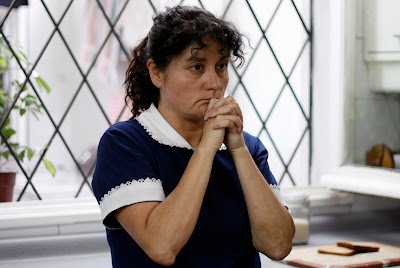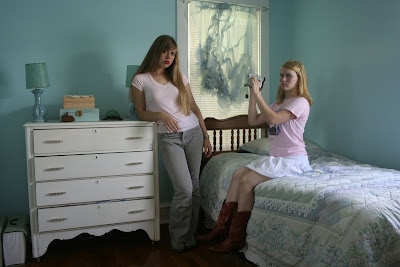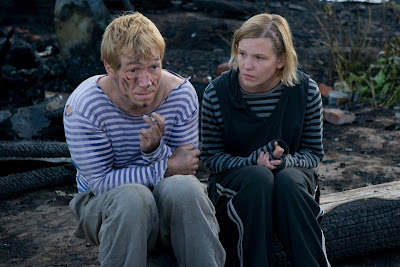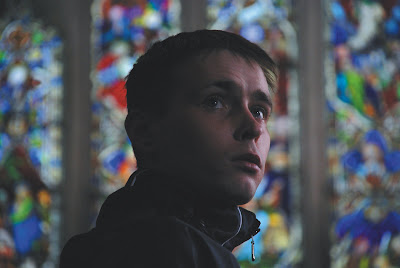The Maid (Sebastián Silva)

A cross between Luis Bunuel and Chantal Akerman’s Jeanne Dielman, The Maid focuses on Raquel (Catalina Saavedra), the titular servant who has been serving her family for over two decades. Repetition and routine, as well as her long separation from her own family, have taken their toll on her mental health, as she constantly pops pills to ease her splitting headaches, and becomes increasingly passive-aggressive toward the family, especially the eldest daughter, who cuts her to the quick by reminding her that she’s just the hired help and not a true member of the family. A young maid from Peru (Mercedes Villanueva) is hired to help out after Raquel’s condition begins to affect the quality of her work. Raquel takes this as an insult and a threat to her status in the family, and proceeds to terrorize the new girl. Silva’s camera tracks sinuously through the house (he shot the film in his own family home), subtly raising the tension between the maid and the other members of the house. Saavedra (who won an acting prize at Sundance; Silva also won the Grand Jury Prize in the world cinema dramatic category) makes this forbidding, opaque character increasingly sympathetic as we discover more about her. (March 27, 29)
Parque vía (Enrique Rivero)

Another intensely penetrating character study is at the heart of Parque vía, an unnervingly quiet film which retains its riveting intensity right up until the conclusion, which still startles even though such an ending is somewhat anticipated. The film’s central figure, Beto (Nolberto Coria), is the custodian of an empty house in Mexico City, where he has been living for ten years while his elderly boss (Tesalia Huerta), called “Lady” in the credits, searches for a buyer. “I’m a weird man,” Beto says of himself at one point. The initial scenes take us into his daily routine, where he lives in (to him) glorious isolation. The only people he interacts with on a regular basis are his boss and Lupe (Nancy Orozco), a prostitute whom Beto takes an almost fatherly interest in, despite his frequent use of her services. Beto has developed a form of agoraphobia as a result of his self-imposed separation from the world. In one brilliantly staged scene, on a rare outing in the daytime, Beto is overwhelmed by the noise and bustle of the outdoors, and faints in a supermarket. When the house finally has a buyer, and Beto is about to be expelled from the careful cocoon he has wrapped around himself, Beto resorts to extreme measures to preserve the life he has become so used to. Rivero proves to be remarkably adept at calibrating a slow-burn mood of tense anticipation, in which it becomes clear that the quiet prevalent in much of the film will be violently disrupted. Rivero is also an apt disciple of the minimalist mode of Mexican filmmaking that is a hallmark of such directors as Carlos Reygadas and Amat Escalante, to name a couple. In fact, a remarkable 360-degree panning shot recalls a similar one in Reygadas’ Battle in Heaven. However, Rivero brings a penetrating, sensitive approach to character on the table that make the central character of Beto a fully realized one, rather than a blank cipher, as too often happens with spare films such as this. The effect is also greatly aided by Coria’s riveting performance. An opening title tells us the film is based on his life, and indeed Coria in real life is the sort of caretaker depicted in the film, although of course this film is far from a documentary. (April 4, 5)
The Milk of Sorrow (Claudia Llosa)

The title of Claudia Llosa’s film refers to what has been passed on to Fausta (Magaly Solier), the traumatized woman at the center of this film, whose mother was a rape victim during Peru’s brutal 20-year civil war before regime change in 1990. The terror that her mother experienced, which Fausta witnessed while in the womb, was transmitted to Fausta through her mother’s breast milk. (The film’s title in Spanish translates as “The Frightened Breast.”) In the film’s extraordinary opening, Fausta’s mother sings about her brutal rape and the murder of her family in front of her on her deathbed. After her mother dies, Fausta struggles to find a way to give her mother a proper burial, which entails making a long trip which she must raise money toward. Fausta separates herself from others, and has planted a potato inside her vagina to prevent what happened to her mother from happening to her. Fausta is the living aftermath of this dark period of Peruvian history, and she remains consumed by the terror of this time. Fausta’s fear and extreme discomfort is contrasted with the colorful wedding ceremonies she works at along with her uncle. Llosa’s beautiful sense of composition, along with her understated use of magical realist elements, makes this a mesmerizing and memorable work which astutely connects personal and national trauma in an indelibly vivid way. (April 1, 3)

















